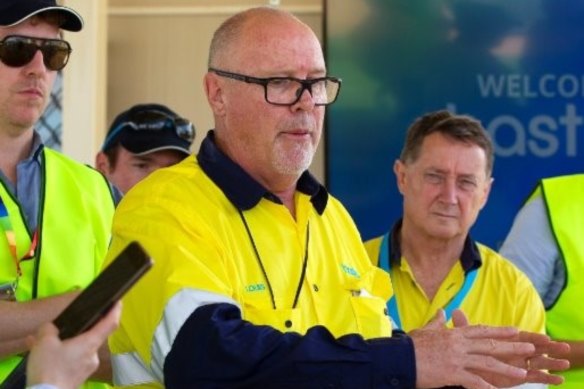
Hastings Technology Metals has revealed a sizeable maiden niobium oxide resource estimate at its Yangibana rare earths project in Western Australia’s Gascoyne region, with 6.7 million tonnes grading 0.23 per cent for a total of 15,501 tonnes of contained metal.
While niobium – which is used in alloys including stainless steel – has been instrumental in shifting the share price dials of several ASX-listed companies in recent times, Hastings is also pursuing wider, multi-commodity value from the site that sits 250km north-east of Carnarvon, with a view to establishing an updated Yangibana mineral resource estimate by November. It is expected to include additional critical minerals such as zirconium and hafnium.

Hastings Technology Metals chief geologist Dr Louis Shurmann at the company’s Yangibana rare earth and niobium project in WA’s Gascoyne region.
Management says the shallow, niobium-bearing zones at Yangibana stretch across a 4km strike length and are predominantly found within the Gifford Creek carbonatite – the predominant host rock at its Bald Hill and Simon’s Find deposits. The metal primarily shows up at its highest grade as an element within the mineral ferrocolumbite.
‘Yangibana’s multi-commodity potential is being expanded through further exploration and ongoing metallurgical testing of hafnium-enriched zircon.’
Hastings Technology Metals chief geologist Dr Louis Schürmann,
With metallurgical testing already well-advanced, Hastings has identified effective methods to recover niobium from the ore, including the use of magnetic separation and flotation techniques. It suggests that the niobium can be efficiently extracted alongside rare earths, adding another revenue stream to the project.
Hastings Technology Metals chief geologist Dr Louis Schürmann, said: “The maiden Niobium Mineral Resource Estimate is an important step towards providing a multi-commodity recovery process stream and byproduct credit income. Yangibana’s multi-commodity potential is being expanded through further exploration and ongoing metallurgical testing of hafnium-enriched zircon.”
In August, while taking rock-chip samples from carbonatite-related ironstone intrusions in the footwall of its Bald Hill deposit in a bid expand its niobium footprint, the company noted promising signs of zirconium and hafnium mineralisation within niobium readings that peaked at 23.69 per cent and total rare earth oxides (TREO) running as high as 8.91 per cent, with average grades of 1.21 per cent TREO.
With a mix of 49.05 per cent zirconium to 3.78 per cent hafnium, the discoveries revealed a zirconium-to-hafnium ratio of 13:1, or 3.8-times higher than the global benchmark of 50:1 as cited by the United States Geological Survey (USGS).
Hafnium, primarily a byproduct of zirconium refining, is crucial in nuclear technology, especially in control rods for nuclear reactors and submarines. The metal is also alloyed with other elements such as titanium and niobium for intense-heat purposes in electronics and aerospace.









 Add Category
Add Category